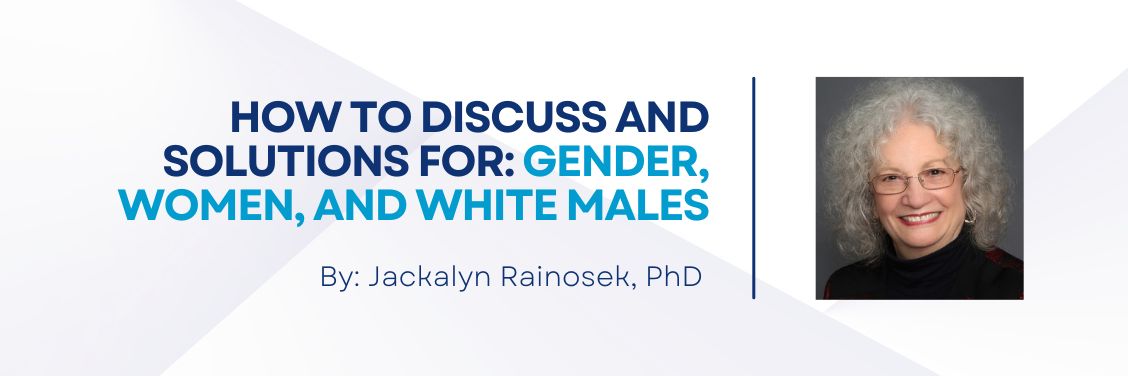How to Discuss and Solutions for: Gender, Women, and White Males

Questions to Ask in the Boardroom
- As board members, what do you know about gender issues such as gender identity and expression, which relate to how people see themselves?
- What are the facts about the number of women that are on boards today?
- Are white males an asset to diversity initiatives, and what will they need to learn to utilize their position and knowledge to help diversify boards?
Introduction
As a consultant for organizations and boards, I combined the old baselines identified and developed new baselines. In 2002, Frederick A. Miller and Judith H. Katz wrote the book, “Unleashing the Real Power of Diversity”, San Francisco, Berrett-Koehler Publishers, Inc, pages 82-94, they gave a more limited version of the old baselines and addressed the new baseline in the nine areas. I have combined my list with their list since it is a more accurate way to assess a board or organization’s composition.
Gender
For years, most organizations provided limited knowledge about personal identity and gender; therefore, the work environment was not open and receptive to dealing with gender issues. Efforts were made to start emphasizing gender-neutral terms (e.g., police officer instead of policeman, or firefighter instead of fireman), which created a more accepting workplace. As individual members of organizations came forth with their conflicts with gender identity and expression, the organization addressed it on an individual basis. This allowed organizations to start understanding the difference between gender identity and sexual orientation. Gender identity resolves confusion that people have about themselves. When board members are uninformed or unaware of gender issues then they cannot effectively provide support to organizations that are more open to gender identity.
Today’s baselines for programs about gender create understanding of the importance of gender identity and expression and help to establish a respectful and inclusive work environment for all people. Boards and organizations find themselves needing to learn to respectfully discuss gender, gender identity and how individuals find this important to see themselves clearly. Defining self-using the outdated gender binary system leads to misunderstanding and employees and board members need to be open to different ways of defining gender. Establishing support for people to develop and define themselves helps them to advance and flourish in their professional careers and supports their comfortability with serving on boards. As mentioned in the LGBTQ group, the development of medical coverage that meets the needs of transgender people is essential. Establishing gender neutral bathrooms and spaces where people are comfortable and accepted are also important for a diverse work environment. Board members need to be open to learning about and discussing gender issues, since they will need to address these issues with executive teams and the members of their board. Any kind of unaware or offensives comments will eliminate people who have found the freedom to determine their gender identity. There are 72 gender identities and this document provides information on gender identify if someone wishes to start their study of gender.
Women
The old guidelines focused on having a critical mass at all levels. For decades women have been faced with not being treated as full partners in organizational positions of leadership. There were efforts to smash the “glass ceiling,” which is the barrier that limits women from reaching top executive positions and serving on boards. Women were moved from staff to line positions, providing opportunities to interface with customers as opportunities to assume positions of power and leadership. De-gendering roles and positions goes beyond just having women on the payroll. De-gendering opens avenues for success and acknowledges that leaders can embody many different approaches and styles that contribute to greater success for organizations and boards.
Today’s statistics on women serving on boards is still lower than men. Here is an excellent description of what is dysfunctional about boards and the reason more women are not on boards. A major contribution women make is found in this Harvard Business Review article about women impacting CEOs. When considering racial groups, this gives an even greater picture of the lack of diversity of board composition whether it is private or public organizations. A Harvard Law School Forum document provides current statements about what drives racial diversity, which I think board members can review and determine what they need to do with their own board as they consider the new baselines.
New baselines include some changes that seem simple; however, they speak to the heart of the issues about women serving on boards or being upper-level executives in organizations. Here are suggestions for boards and organizational members. They need to stop using the word “subtle” to describe any form of harassment or limitation of women’s potential, since it is never subtle. Harassment is painful and hurtful. Being “passed over” is painful and hurtful. The change of focus has moved from what not to do, to what to do to find ways to include women. Establishing two-way mentoring that goes beyond the “glass ceiling” for white women and that addresses the “sticky floor” (also known as the “concrete ceiling”) for African American, Blacks, and women of color is still lacking. Addressing the differentiation between African American, Black women, women of color, and white women is imperative instead of lumping all women together when they are considered for boards or organization positions. Addressing the distinct challenges among women of color, African American and Black women, as well as the different experiences and needs of women in staff, managerial, and individual contributor roles is important. Individual needs such as applying flextime to all positions, not just exempt employees, telecommuting support, and maternity leave are areas that need to improve for women serving on boards or in organizations. Today’s workplace needs to recognize that women as well as men need to have work, life, and family issues addressed so that women who job-share or take maternity leave will continue to have career advancement opportunities. This is true for women who serve on boards.
White Males
As I provide DEI programs and help to form diversity initiatives, white males are usually grateful that the list includes them. As Judith Katz, Fred Miller and I formed the specific groups, we realized that building and leveraging diversity, equity, and inclusion had greater success when white males were able to enhance their competencies to support DEI work. Historically, white men will support diversity programs when they have the knowledge about how diversity benefits the organization and them. They can also learn how not knowing or experiencing the challenges that other groups have minimizes the white men’s own development. By including them in the diversity initiatives they can let go of the fear of diversity that might exclude them. Boards and organizations need to focus on wanting diverse candidates. White men’s fear can be resolved by seeing the rich experiences that come from a diverse board or workforce. This requires creating an environment in which more than one type of white male can be successful. Increasing white men’s competencies to effectively partner, engage, manage, and interact contributes to a diverse work environment and board experiences.
Current baselines focus on expanding networks and two-way mentoring so white men can explore their own diversity and how to be more effective partners in the change process. They are not the only source of the problem related to DEI. They can develop skills and abilities to integrate diversity, inclusion, and higher performance through DEI programs as a board member or employees of an organization.
It is important to recognize the work, life, and family integration issues of men and expand networks to include white males. They have things to learn even though they have been in the “one-up” position in the past. They have been trapped in the traditional way of doing things, blinded by their immunity from the experience of other identity groups. They need an open and honest two-way mentoring partnership to learn about and see the organization and the world from a different perspective. This gives them the opportunity to receive coaching and be able to support other white males in the organization. They also can learn the value of knowing and experiencing men from other identity groups. These comments can help design discussion and programs about how white males have an opportunity to contribute to the advancement of DEI programs and initiatives. It is essential for the advance of DEI to utilize the power and influence of white males on boards.
More Questions for Board Members to Consider
- If you are going to invite a person to join the board, what do you think you will need to know about gender to be able to be respectful of differences of gender identity and expression?
- What have been the challenges for women serving on boards, and what will your board do to establish new ways of including women on the board?
- White males can be major contributors to the success of diversity initiatives. What will board members need to know to be able to support white males being a part of diversifying the board?

ABOUT JACKALYN RAINOSEK, PHD
Dr. Jackalyn Rainosek is CEO and Co-Founder of DTP Leadership Group, as well as founder and principal of DTP Business Strategies. She has worked extensively with a wide range of Leaders as they make strategic decisions in ever-changing circumstances to achieve extraordinary results and increase profitability. As a senior business consultant and marketing strategist Dr. Rainosek works with business owners and corporate executives to generate optimal results and exponential growth. Dr. Rainosek guides organizations to develop more appropriate leadership styles, enhance cultural competency (through diversity, equity, and inclusion initiatives), and improve levels of trust and cooperation both internally and with the customer base.
Disclaimer: The views and opinions expressed in this blog are solely those of the authors providing them and do not necessarily reflect the views or positions of the Private Directors Association, its members, affiliates, or employees.
